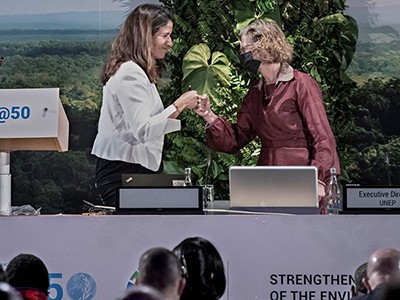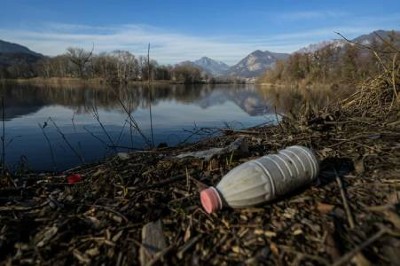[ad_1]
Negotiators from around the world are gathering in Ottawa this week to try to hash out the text for a new international treaty on plastic pollution. The delegates are short on time: the treaty process, which started in 2022, is due to be finalized this December. But they are not short on science, thanks to a surge of new data and models from researchers aiming to inform the talks.
“I’ve never seen a new diplomatic process move this fast and science trying to catch up,” says Margaret Spring, a legal expert and conservation manager at the Monterey Bay Aquarium in California.
Landmark treaty on plastic pollution must put scientific evidence front and centre
Observers hope the treaty will cover all aspects of plastic production and disposal; it could, for example, limit how much plastic is produced or set up financial mechanisms to aid waste management. But the treaty process has been hindered by disagreement, with some member states arguing against tough measures such as caps on the production of virgin plastic. It is unclear whether and when a treaty will be agreed.
In the run-up to the final negotiations, researchers have been publishing more reports, data sets and models about plastics than ever before. “I definitely feel that sense of urgency and rush,” says ecologist Douglas McCauley at the University of California, Santa Barbara, who is attending the negotiations. Researchers have also organized groups, such as the Scientists’ Coalition for an Effective Plastics Treaty, to advance the profile of scientific evidence at the meetings. Nature spotlights some key statistics on the outcome of proposed policies and the effects of plastic waste.
122 million tonnes of mismanaged plastic waste
The treaty was originally conceived as a mechanism to end plastic pollution, which is sometimes taken to mean driving the amount of ‘mismanaged waste’ to zero by 2040. Mismanaged waste is plastic that isn’t recycled or disposed of in a well-managed landfill or incinerator, but rather ends up loose in the environment or burned in an open pit.
Annual production of plastics has grown exponentially, from about 2 million tonnes in 1950 to 460 million tonnes in 2019 (current levels are on track to triple by 2060). Mismanaged waste is hard to measure, given the vast number of sources, but McCauley estimates that about 74 million tonnes are currently produced each year. His modelling suggests that by 2050 this figure will reach 122 million tonnes per year, under business-as-usual projections. Unless policies change, the peak of mismanaged plastic waste “is nowhere yet in sight”, he says.
Buried microplastics complicate efforts to define the Anthropocene
McCauley’s team and others1 have modelled how policies that could be included in the treaty would affect waste. Their work shows that getting close to the ‘zero waste’ goal requires a mix of strong measures, including both downstream efforts (such as increasing recycling) and upstream ones (such as capping virgin-plastic production). “You have to do everything,” says Spring, who chairs an expert group on plastic for the International Science Council, a Paris-based coalition of scientific agencies, that is providing science-based advice on the treaty’s draft language.
The models also show that a cap on plastic production — a particularly contentious topic during the negotiations — is one of the most powerful levers for cutting pollution.
McCauley and his colleagues used their modelling results to create an online tool to help negotiators to understand the implications of their choices. With a single mouse click, delegates can find out how a particular bundle of policies affects waste levels. A suite of 11 policies that negotiators are discussing could by 2050 whittle the amount of mismanaged waste down to 41 million tonnes.
6.78 gigatonnes of greenhouse gases
A new report from environmental-policy researcher Nihan Karali and her colleagues at Lawrence Berkeley National Laboratory in California concludes that plastic production generated the equivalent of 2.24 gigatonnes of carbon dioxide in 2019, mainly from the energy-intensive process of extracting and refining the fossil fuels used to generate the petrochemicals that make up most virgin plastic2.
The report projects that those emissions will triple to 6.78 gigatonnes by 2050 if plastic production grows by 4% each year — a figure similar to annual production growth since 2010. That means that, over the next 25 years, cumulative plastics production alone would gobble up more than a quarter of the total carbon that can be emitted if the Earth’s temperature is to rise less than 1.5° C above pre-industrial levels, the preferred goal of the landmark Paris agreement on climate change.
McCauley’s model shows that the same 11 policies that could slash mismanaged plastic waste could cut greenhouse-gas emissions in 2050 by 26% below business-as-usual projections. But McCauley cautions that his group’s projections do not include estimates of the emissions produced by any materials used to replace plastic.
4,200 chemicals deemed hazardous
An individual plastic typically contains hundreds of chemicals — many of which are toxic and can leach out — that make the material more flexible, water repellent, flame retardant or resistant to ultraviolet light. Last month, researchers released a report listing 16,000 chemicals associated with plastics, of which they found at least to be 4,200 hazardous.
The most comprehensive report on health effects from plastics thus far is ‘The Minderoo-Monaco Report on Plastics and Human Health’3, which a global team of scientists published last year in Annals of Global Health. That report, which Spring worked on, estimates that in 2015 the health costs of disease and disability caused by plastic-associated chemicals were more than US$920 billion in the United States alone. New work is helping to find specific health links, says Spring: a study published in February of some 250 people undergoing surgery showed that nano- and microplastics in carotid-artery blockages were linked to increased risk of heart attacks, strokes and death4.
“A number of groups are saying you must, must, must focus on public health,” says Spring.
[ad_2]
Source Article Link



